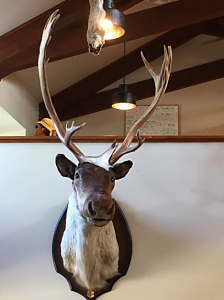
by Anne Kilgannon – As we traveled the Yellowhead Highway through central British Columbia eastward toward a family wedding in Alberta this August, I saw many crows in twos and threes along the verge of the road, seemingly waiting, for what I don’t know. We also glimpsed elk, deer, and Bighorn mountain sheep, but the animal I most wished to see (but did not expect from my vantage point of a car window), was a temperate rainforest caribou. I did find one: a taxidermy trophy in a tourist rest stop. I was chagrined to find myself gazing at the unanimated face that held only a hint of its former being amidst the swirl of information seekers heading out for hikes. I felt protective but helpless to caution the adventurers not to thoughtlessly further encroach on its shrinking habitat.
Caribou were much on my mind, thanks to reading David Moskowitz’s sensitive and evocative book on this elusive animal before we set out for our trip. I was surprised to learn that my often-traveled mountain route ran right through the home of caribou that I never knew were there at all. Moskowitz had also stumbled upon the existence of the caribou by chance, but now they have captured his heart, inseparable from his love of the mountains that drew him to the high and wild backwoods. He gives us the results of his discovery, tenderly laying out his case why we should all care deeply about the survival of the caribou and the land which sustains them. He has transformed for me that stretch of highway and opened my eyes to its extraordinary hidden beauty and promise.
It is a world, a place apart, created by the particular formation of the surrounding mountains interacting with streams of moisture-laden air that creates the rare environment that supports the existence of rain forest caribou. So fine-tuned and shaped by this magnificent terrain of deep forests and alpine meadows have the caribou become that they cannot survive outside its bounds. They depend—to a precarious degree—on the nutrient-rich veils of lichen that grow in the high country for their sustenance in winter, and upon the isolation of the deep snow for their safety. Their ability to live in such a place, Moskowitz explains, is also, alas, the source of their vulnerability, as logging eats away these forests and climate change alters winter conditions. As the deep snow melts, wolves abound; as the climate warms, moose and deer invade, bringing disease and competing for food sources.
Moskowitz is a powerful and empathetic writer; his photographs also eloquently reveal these shy creatures of the forest. How he managed to capture these images one can only imagine the patience and hardship involved. Paging through this beautiful book is like taking a journey to an exotic country, Tibet, say. But the habitat for the caribou stretches from Montana and Idaho, cutting across the northwestern tip of our own state, and up the central mountain range of British Columbia, reaching past Jasper National Park. This is our back yard. This is our concern, within our range of responsibility. The caribou are members of the list of other highly specialized species like the spotted owl, orcas, and marbled murrelet, who depend on very select environments and food sources and cannot adapt quickly enough to the disruption imposed by human actions and changing conditions.
It is an unusual strength of Moskowitz’s book that he includes indigenous peoples native to this mountainous area as well as more recent settlers, the timber workers and their families who live in the small towns dotting the map, in his list of those threatened by development. He writes of their cultural and economic plight, the destruction visited upon both groups by the advent of non-resident corporate decisions reshaping the forestry practices of the area, some of the same forces threatening the caribou. But Moskowitz finds these two groups also have the greatest potential to craft solutions to the problems besetting the local people and the caribou alike. By working together, all can be helped. This is where he finds hope in this heartbreaking situation. Though he does not name it this way, Moskowitz is proposing a version of the Green New Deal to save the caribou and address the economic hardship experienced by First Nations people and timber workers with a return to a way of logging more attuned to wildlife needs and local human needs. There are modest beginnings of sustainable logging in the area and help for caribou survival; there is still hope for these beautiful animals we may never have heard about before.
It’s only October but I am thinking about the approaching gift-giving season and considering giving copies of this book to family and friends as part of “doing something” for the caribou. I spied a stack of signed copies at Browsers….it would be a start of spreading knowledge and building concern. And I’m looking for ways to do more. This is a heart-opening book.







